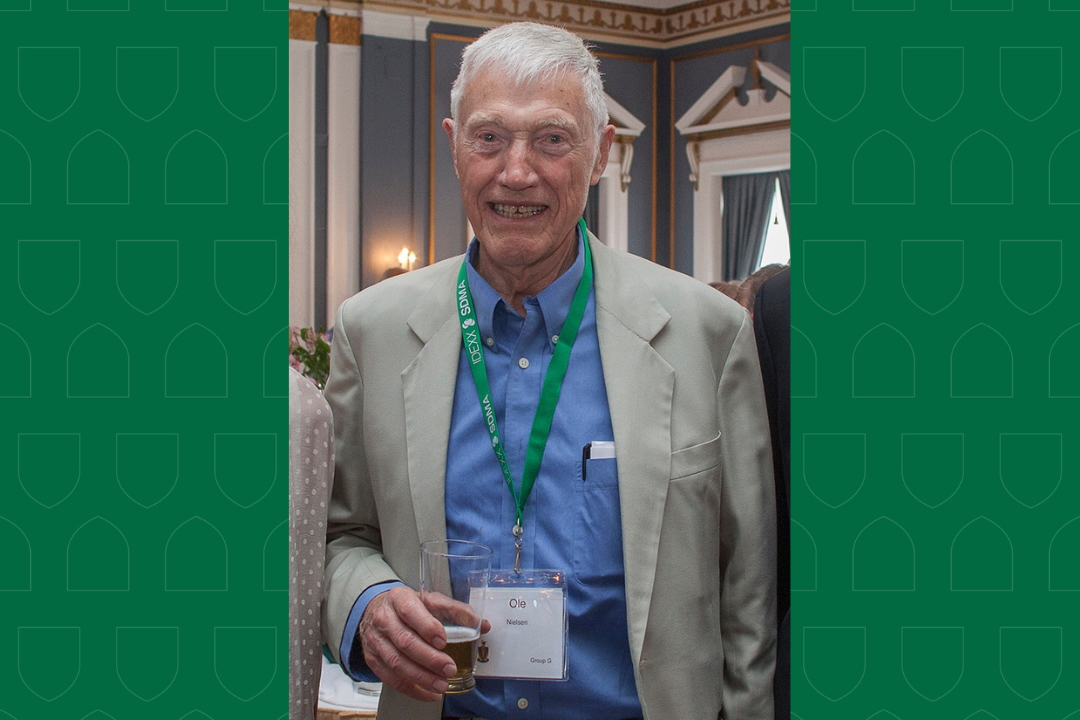
Veterinary medicine’s ‘balloon pilot’: Dr. Ole Nielsen
Dr. Ole Nielsen (DVM, PhD), a former dean of the Western College of Veterinary Medicine (WCVM) and one of Canada’s veterinary visionaries, passed away on Wednesday, May 28, at the age of 95.
By WCVM TodayNielsen was predeceased by his wife Marilyn, who passed away in 2019. He is survived by the couple’s three children — Margo, David and Gordon — and five grandchildren.
Originally from Edmonton, Alta., Nielsen received his Doctor of Veterinary Medicine (DVM) degree at the Ontario Veterinary College (OVC) in 1956 and his PhD from the University of Minnesota in 1963. He joined the University of Saskatchewan (USask) in 1964 as an associate professor of veterinary pathology, and as one of the college’s founding faculty members, Nielsen was heavily involved in the design and construction of the new regional veterinary college that opened in 1968. The WCVM’s first class of Doctor of Veterinary Medicine (DVM) students graduated in 1969.
Nielsen became a full professor in 1968 and was appointed head of the WCVM’s veterinary pathology department in the same year. Keenly interested in environmental health, Nielsen was among a team of USask researchers who first established that mercury pollution was a problem in Canada and a potential hazard to humans and animals.
In addition to ecosystem health and conservation, Nielsen conducted research in the areas of livestock disease and biomedical science. Throughout his six-decade career, he was also involved in contributing ideas and concepts focusing on veterinary professional affairs and education.
After the WCVM’s first dean, Dr. D.L.T. (Larry) Smith, died suddenly in 1974, Nielsen stepped into the role and served as the college’s dean for eight years. Among his many actions as dean, Nielsen spearheaded the creation of three WCVM-based research funds for equine health, companion animal health and wildlife health — organizations that have raised millions of dollars supporting vital animal health research in the last five decades.
When Nielsen left Saskatoon in 1984 to become dean of the OVC at the University of Guelph, his WCVM colleagues joked that they would miss all the “trial balloons” floating out of his office.
“Most ideas were shot down, but I would just come up with something new,” said Nielsen in a 2000 interview. “I’m a balloon pilot.”
During his time in Ontario, Nielsen’s interest in environmental health helped form the International Society for Ecosystem Health. He was also chair of the board of trustees for the International Laboratory for Research Animals and Disease from 1991-94.
After serving as OVC dean for nine years (1985-1994), Nielsen retired in 1995. In the following year, USask presented Nielsen with an honorary Doctor of Laws in recognition for his many contributions to the WCVM and the university. During his time on campus, Nielsen played instrumental roles in establishing the Prairie Swine Centre, the Toxicology Centre and the Veterinary Infectious Disease Organization (now known as the Vaccine and Infectious Disease Organization or VIDO).
Even after retirement, Nielsen remained closely connected to veterinary medicine and continuously advocated for greater involvement of the profession in ecosystem health and ecological medicine.
“Environmental aspects will only become more important and properly trained people will have access to jobs. But somebody has to earn our way in or other professionals will fill roles best suited to veterinarians,” said Nielsen, who presented his views as part of the J.G. Rutherford Memorial Lecture at USask in February 2000.
Among his many interests, Nielsen co-chaired a science advisory panel for a western Canadian research project that investigated the potential effects of the oil and gas industry on animal health and productivity. He participated in African international development initiatives for nearly a decade in the late 1990s.
He also enjoyed making pottery — a hobby that he took up in the early 1970s while at the WCVM. After retirement, Nielsen donated the proceeds from his pottery sales to support the McEachran Fund for Ecosystem Health, a trust fund that he established in 2007 with the aim of encouraging Canadian veterinarians to address ecological health issues.
Nielsen played an important role in establishing the new Faculty of Veterinary Medicine at the University of Calgary in 2008, and for his efforts, he received the Order of the University of Calgary in 2012. Four years later, Nielsen was appointed as a Member of the Order of Canada — one of the country’s highest civilian honours — in recognition of his many contributions to veterinary medicine as an academic, administrator and leader.
Nielsen was 92 years old when he played a key role in establishing the McEachran Institute in 2022 — Canada’s first think tank dedicated to accelerating One Health-related action and knowledge. In January 2024, the Canadian Veterinary Journal published “Imagining veterinary medicine and education in 2040,” a commentary on the profession’s future written by Nielsen.
Nearly 70 years after graduating from veterinary school, Nielsen’s fondness for “floating balloons” was as buoyant as ever — something for which the profession will be forever grateful.
